The great American writer and critic, Albert Murray (1916-2013), felt that art should make sense to a person. He believed in artistic struggle and creativity, not as a means to achieve fame or wealth, but as a way to evolve personal order in the world and to comprehend one’s place within it. When I read that in The Economist magazine (August 22, 2020), I cheered. He put into words what I’d deeply felt since I began my art career in the 1970s.
The most consistent and sensible experience of my life has been meditation. In my twenties, I dedicated my art to my beloved contemplative endeavors which included silent sitting, mental exercises, chanting, rituals and prayer. I wanted to celebrate the practice that gave me so much inner growth, the source of much religious art, I imagine. I also needed to explain to others exactly how meditation benefited me.
When I first learned to meditate, at age ten, taught by a gentle third cousin who practiced osteopathic medicine, I clutched at it like a life preserver thrown to a struggling swimmer, drowning in her thoughts.
According to my cousin, I could calmly observe my mind as it flashed visions like film strips projected on a screen? This came as a revelation to me. My ambitious parents lived to party. Between work and play our household maintained a dramatic intensity that never stopped. The concept of relaxation stunned me with its newness. My cousin taught me to count backwards and imagine myself bouncing downward from cloud to cloud to unwind. I fell in love with this new quiet and private part of me.
After relaxing, he instructed me to watch the internal spectacle in my mind’s eye. He told me I could decide which parts resonated as true and which didn’t. He patiently taught me I could accept the true parts and reject the false. This constituted a true revolution in my life. I knew I preferred to be alone. The endless parties upset me, but, in our house, they sat at the top of our family’s values. I felt wrong and out of place at home. In meditation, I saw this clearly and resolved to stay away from the partiers at night.
Meditation made supreme sense to me, even as a child. In college, I learned more about traditional contemplative practices from Asia and India. I came to understand that, in meditation, sometimes powerful emotions rose up, ones I would’ve rather ignored. But, when relaxed, I could look at them, as I’d learned to do in childhood. When I observed them in a neutral manner, I became able to cut through a psycho-babble interference layer and get down to an essence. Sometimes extraneous preoccupations floated away. Or perhaps an insight arose that helped me cope with a situation. The Tibetans called this process a compassionate witnessing of your feelings.
When I studied art, I wanted to draw and paint the wondrous meditation process that remained crucial to my daily life. Using a template of my body in the typical cross-legged, seated lotus posture, I tried to express my meditation experiences in paint.
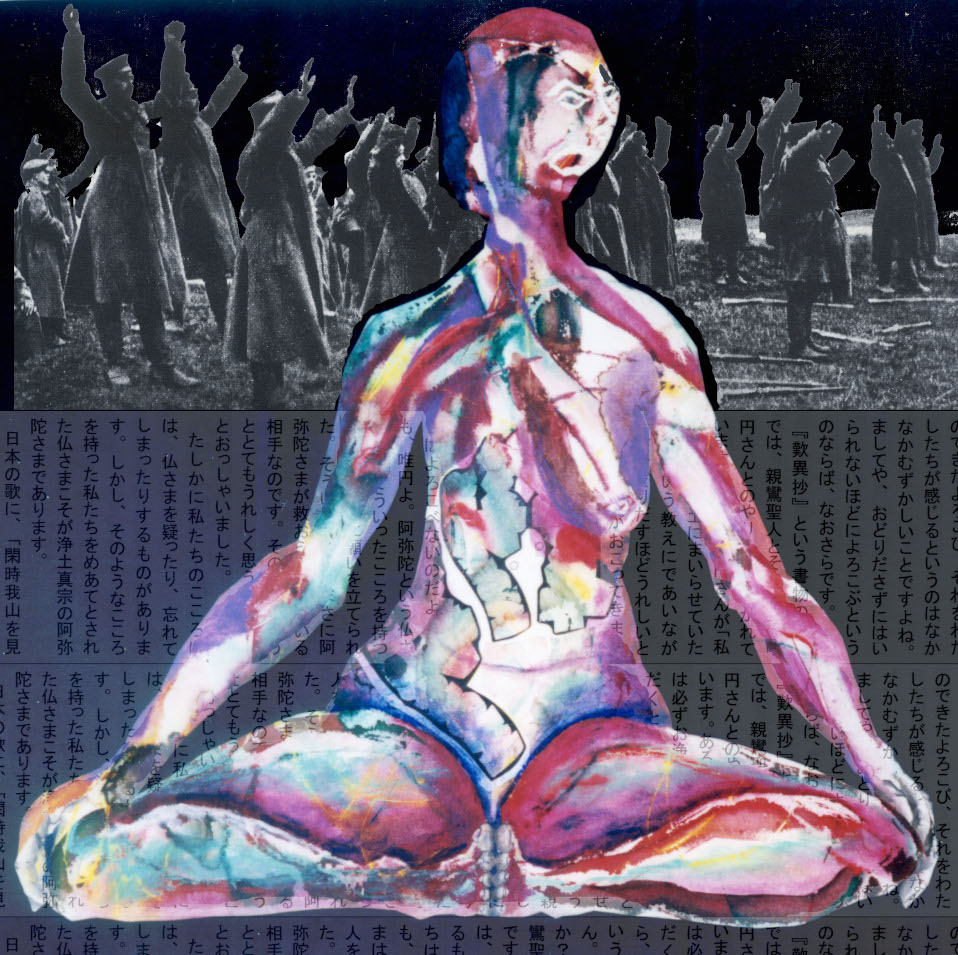
In Angry Meditation, in spite of turbulent emotions depicted by my face and abstract designs within my body, I stayed in the traditional meditation posture, calming in and of itself. My body position and intention to observe and learn, helped to keep me grounded. In the background, I positioned a historical photograph of men in war surrendering: their raised arms moved me deeply. I placed the Buddhist Heart Sutra next to them, as if giving the young men a message of great compassion. These two images together reminded me that I could surrender my anger with kindheartedness for myself and others. Amazingly, both creating this art work and meditating with it quieted me and provided space for intuition to grow.
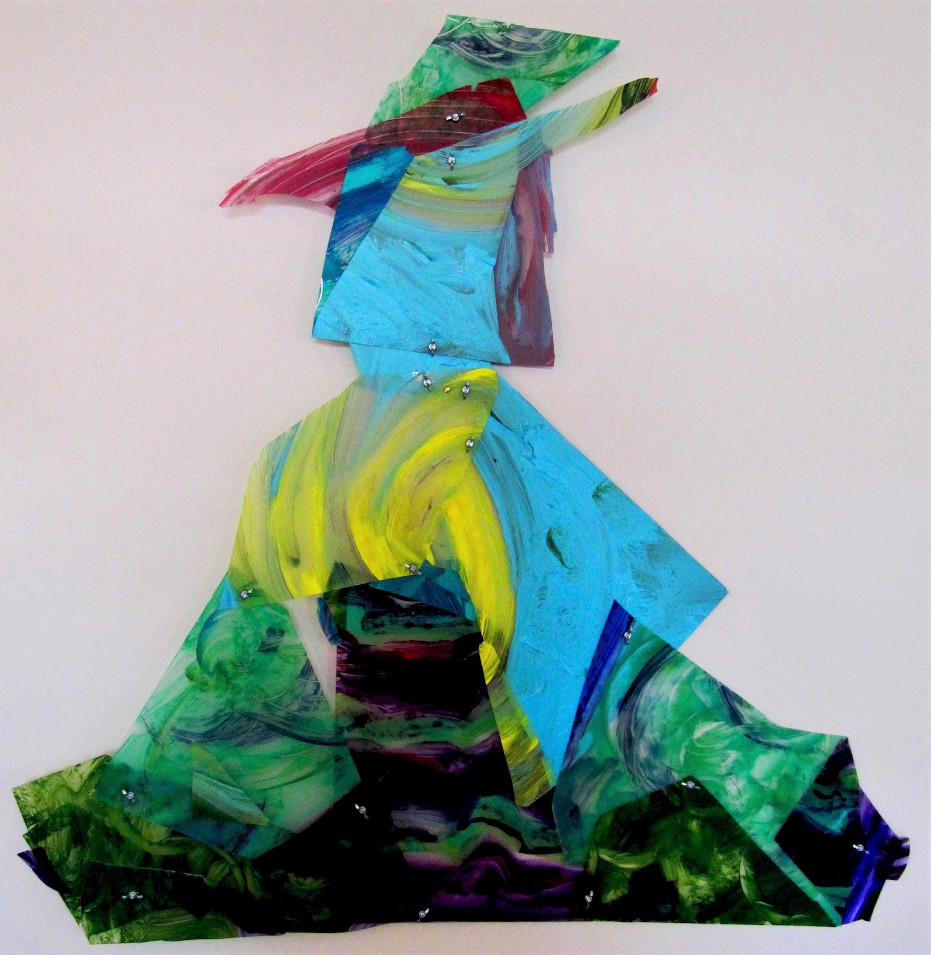
This life-sized Plexiglas construction of an abstract meditating figure depicted two different directions above the head, so I named this piece Two Direction Meditation. Often, I sat with conflicting thoughts disturbing me. I attempted to calmly watch the play of ideas, a display of words and images in my visual brain, until their back and forth completed itself. I hoped to avoid compulsive thinking. But, a bestial part of me enjoyed ripping thoughts to shreds. This overanalyzing became destructive in its intensity when my mind got caught up in a frenzy that never wanted to stop. A benefit of meditation has been learning where this interior borderline existed in my mind. When watching my inner dynamics, I tried, not always successfully, to stay on the playful, non-obsessive side.
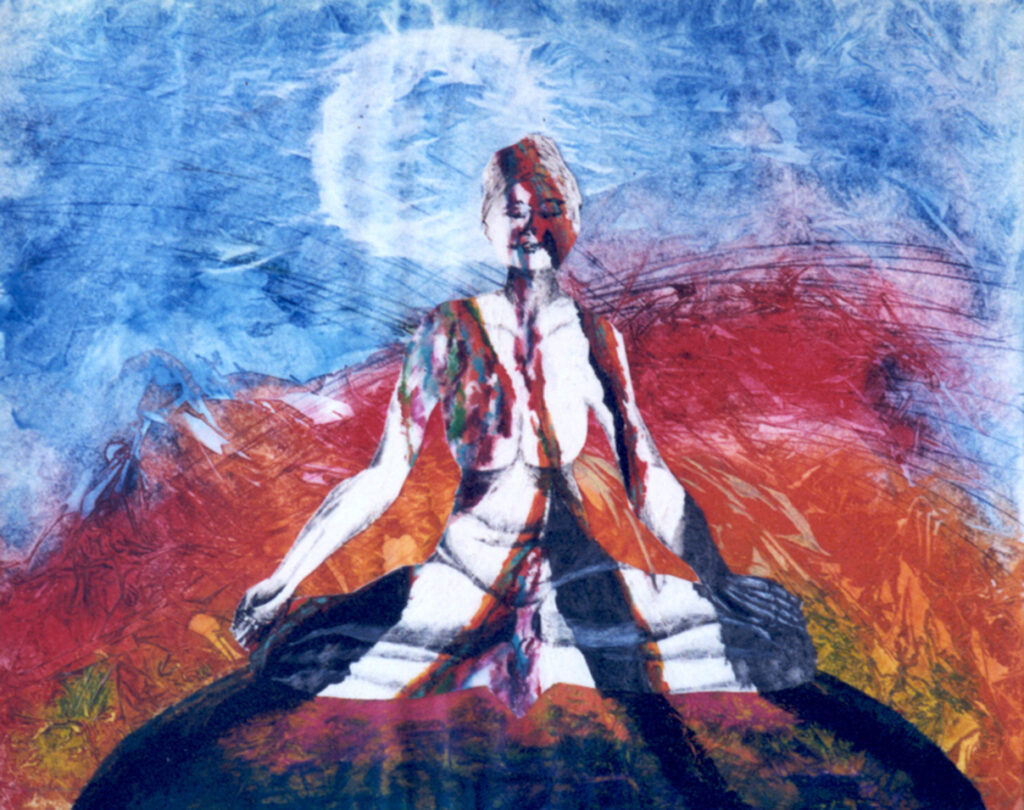
My mind didn’t always show me conflicts during meditation. Sometimes, I’ve relished great joy as seen in Laughing Meditation, an acrylic painting. Light and shadow rested on the figure, representing thoughts floating by my mind, as natural as the real light and shade we saw each day in its eternal visual dance outdoors. The white halo behind the head showed a sense of oneness with the sacred that meditation encouraged. Creating this piece and meditating with it helped me to savor closeness to a beautiful source of energy at my essence.
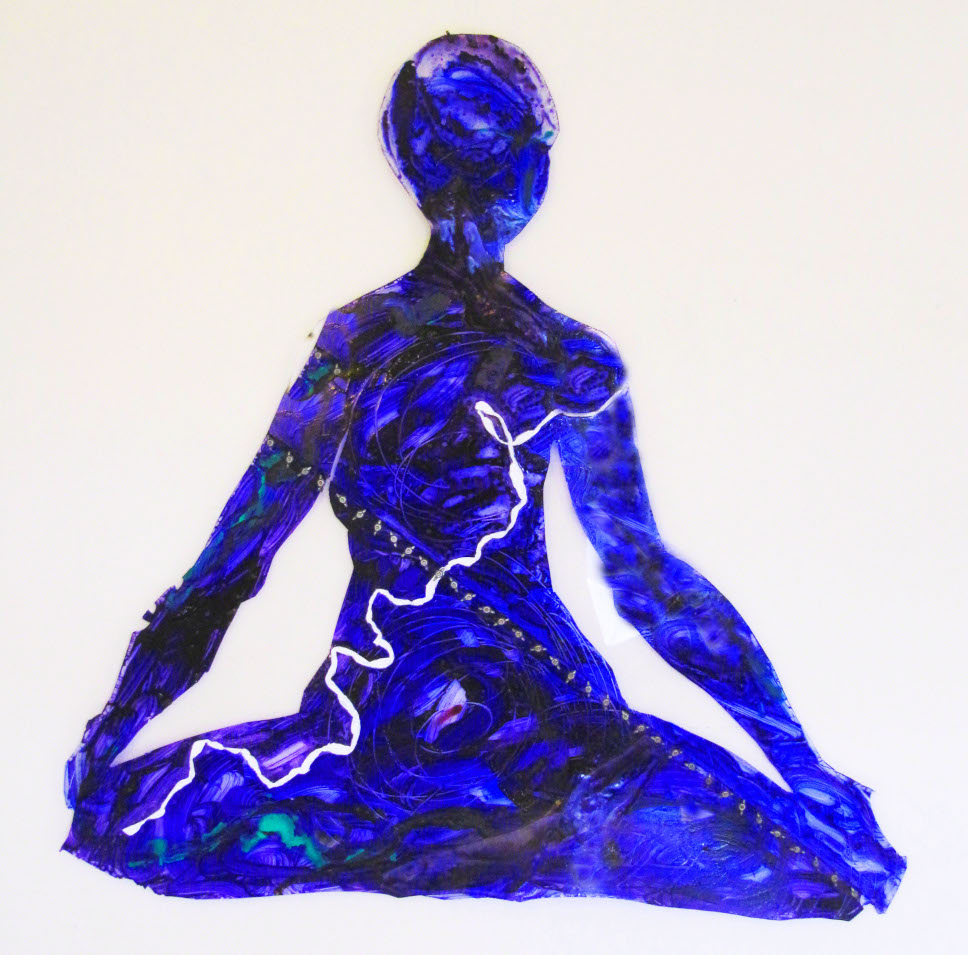
Life-size, and made of Plexiglas with acrylic paint, Journey Meditation showed the gently wandering thoughts that routinely occurred in meditation, represented by the white line. My Tibetan teachers taught me to remain steadfast in accepting my thoughts and letting them go, knowing that a new thought would take its place, ad infinitum. With meditation, mental ideas didn’t disappear, as some people idealized should happen. That’s why I painted the wandering white line, to remind me to accept my natural meandering thoughts, one after another. I sometimes talked to my thoughts, “Hey guys, I know you want the best for me, to offer ways to get along better with that lady at work. Thanks for the problem-solving ideas. Now I need to rest, so let’s go ahead and drop those thoughts for now.” This way, I kept friendly with my mind so it didn’t become a source of struggle. For the most part. Occasionally, an obsession reared its ugly head, usually repetitions of I can’t believe he or she did that. In Journey Meditation, I also included a straight line of evenly spaced wing nuts that intersected with the white line. The geometric precision of the small winged bolts contrasted with the twisting white line, representing two types of inner experiences: the organic and the scientific. Both have taught me a lot and remained precious in my life.
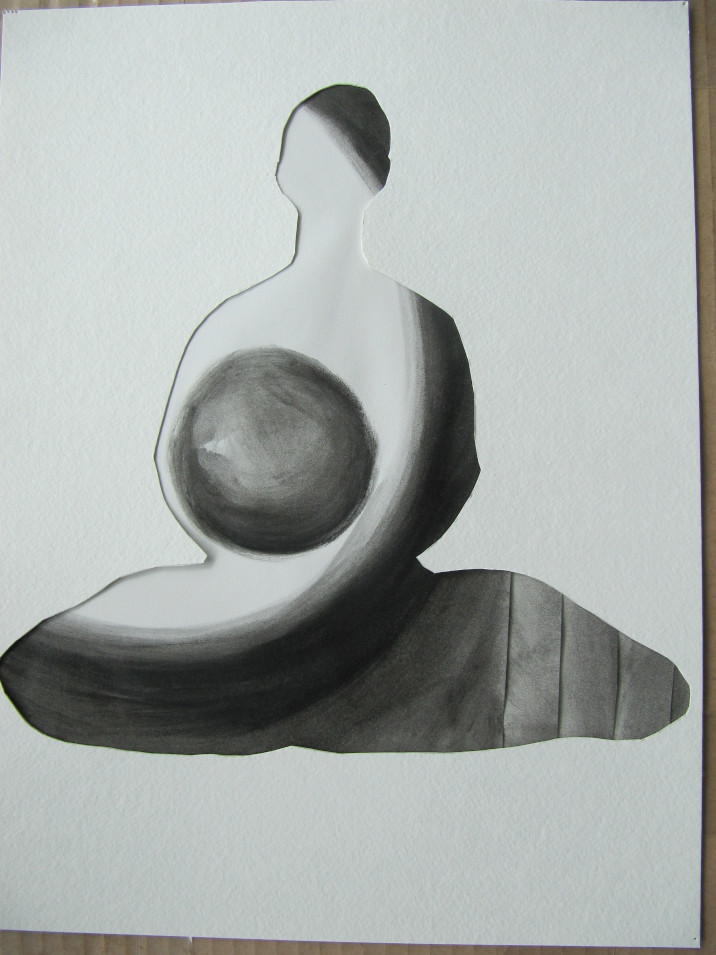
Sphere Meditation, a pencil and charcoal drawing and collage, 20″x20″, depicted the sacred aspects of silent sitting. The circle represented the calm center deep within when I became quiet enough to feel it. The layers of light gray to black showed the fluctuating thoughts that continually ebbed and flowed. I’ve found I could always depend on this solid inner space to sustain equanimity. This drawing hung above my bed, a hallowed spot, as a reminder to clear my mind before sleep. And, I hoped, to bless my rest with peace.
Unconsciously, in this essay, I arranged my meditating figures from wrathful to peaceful, from primal to nuanced, a trajectory I hope reflected my life path.
Thank you, Albert Murray, for explaining the deep urge that has compelled me, throughout my life: to creatively depict the meaning of meditation for me. Like Murray said, I haven’t achieved riches or fame through my art, but I’ve gained something more important.
I possessed a treasured (for me, if no one else) visual record of what my inner life has meant to me. This provided a satisfying feeling at my core and encouraged further contemplative practice. As Mr. Murray suggests, my art established visual evidence of my grounding in the world on a path that made infinite sense to me. Perhaps others can discover, with Murray’s inspiration, what works for them, either by observing art or by some other creative endeavor.
Kaethe Kauffman’s one-person exhibit, La Foresta, is at Castello Gallery 780 in Venice, Italy, April 19 to June 23, 2024. Castello Gallery 780 is affiliated with the Venice Biennale art fair.
